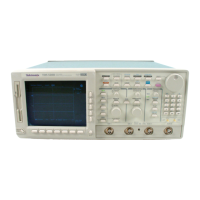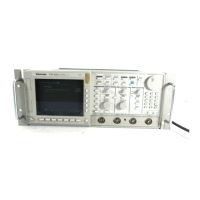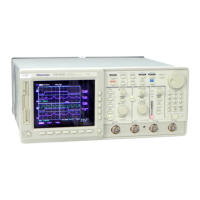Using the FFT
3–34
TDS 340A, TDS 360 & TDS 380 User Manual
Once you have displayed an FFT math waveform, use cursors to measure its
frequency amplitudes.
1. Be sure MATH is selected in the channel selection buttons.
2. Press the front-panel button CURSOR, the main-menu button Function, and
then the side-menu button H Bars.
3. Use the general purpose knob to align the selected cursor (solid line) to the
top (or to any amplitude on the FFT waveform you choose).
4. Press SELECT to select the other cursor. Use the general purpose knob to
align the selected cursor to the bottom (or to any amplitude on the FFT
waveform you choose).
5. Read the amplitude between the two cursors from the D: readout. Read the
amplitude of the selected cursor relative to 1 V
RMS
(0 dB) from the @:
readout (See Figure 3–23).
6. Press the side-menu button V Bars. Use the general purpose knob to align
one of the two vertical cursors to a point of interest along the horizontal axis
of the waveform.
7. Press SELECT to select the alternate cursor.
8. Align the alternate cursor to another point of interest on the FFT waveform.
9. Read the frequency difference between the cursors from the D: readout.
The cursor units will always be in Hz, regardless of the setting in the Time
Units side menu.
Cursor Measurements of
an FFT

